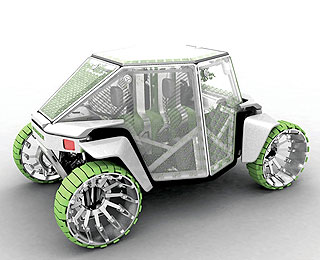2006 GM Hummer 02
(from General Motors Press Release) GM HUMMER O2
Director: Frank Saucedo
Strategy: Steve Anderson
Concept & Design: Jussi Timonen & Jose Paris
3D Modeling: Loren Kulesus, Jussi Timonen & Jose Paris

 In approaching this year’s LA Design Challenge, General Motors Advanced Design, California debated whether absolute efficiency and recycle ability are the only measure of a vehicle’s environmental benefit? Thus launched the basis of our studio’s efforts, a study of whether the daily use of a vehicle could result in a “Net Gain” for the environment? The team drew upon inspiration by growing trends in green architecture and the concept of reducing one’s “Carbon Footprint”. We asked ourselves, “If the typical Los Angeles automobile spends 95% of its time out doors, why can’t that same car give back to the environment?”
In approaching this year’s LA Design Challenge, General Motors Advanced Design, California debated whether absolute efficiency and recycle ability are the only measure of a vehicle’s environmental benefit? Thus launched the basis of our studio’s efforts, a study of whether the daily use of a vehicle could result in a “Net Gain” for the environment? The team drew upon inspiration by growing trends in green architecture and the concept of reducing one’s “Carbon Footprint”. We asked ourselves, “If the typical Los Angeles automobile spends 95% of its time out doors, why can’t that same car give back to the environment?”
The Hummer O2 epitomizes the ethos of the true Southern California outdoors enthusiast with rugged capability, a “tread lightly” contact system and construction methods that promote safety, accessibility, and post-consumer reuse.
Panel Text Body:
“THE HUMMER THAT BREATHES”
Why can’t a car give back to our environment?
We are each responsible for a damaging and non-productive “carbon footprint”- the effect our daily lives have on the earth’s environment.
The HUMMER O2 is an automotive concept which explores the use of basic science principles that would result in a reversal of our daily toll on the surrounding environment. The HUMMER O2 represents
the first time a vehicle has been designed to give back to our environment, in essence, an environmental NET GAIN over the lifespan of the vehicle. The HUMMER O2 concept features a revolutionary phototropic body shell that produces pure oxygen throughout the lifespan of the vehicle. It’s actually quite simple, algae-filled body panels transform harmful CO2 into pure oxygen that is
subsequently released back into the environment. To further reduce environmental impact, the O2’s construction specifies the use of 100% post consumer materials like aluminum (frame), VOC-free finishes (seats) and PETE (glazing).
Details:
PHOTOSYNTHESIS
The phototropic body panels function as the “leafs” of the O2. Each one contains
an optimized photobioreactor where a solution of algae and water transforms
toxic carbon dioxide into pure oxygen. The oxygen is then released back into the
environment as well as inside the cockpit. Oil changes are replaced by annual
algae replacement. The used algae are then recycled as biomass for the
production of energy.
BREATHING
The flow of Co2 and oxygen is regulated by a two-way valve system (“Mistic
Devices” TM) in the corner of each panel. These sophisticated devices control
and monitor the amount of CO2 and source nutrition needed for the algae
cultivation and optimize oxygen production and distribution.
STRUCTURE
A central aluminum “tree” creates a perfect hexagonal structure that both
protects the central hydrogen tank and supports the external structural body
panels. The stiff body panels transform the tree intro a safe enclosed spaceframe
taking care of side impact protection. Front and rear caps connect the
powertrain and suspension (“roots”) firmly to the “tree”.
ENERGY
Four modular and self-contained fuel cells power the hydraulic motors attached
to each wheel. New water-based hydraulic fluid is used. The hydrogen tank is
found in an ideal central location for both safety and structural purposes,
becoming this way the literal and metaphorical “heart” of the vehicle.
FOOTPRINT
Active Tread TM tires provide optimum low resistance when driving on the
highway while still allowing good off-road progress as their shape changes,
adapting to and protecting the soil.
General Motors Corporation
Advanced Design, California
© Source: original article on seriouswheels.com